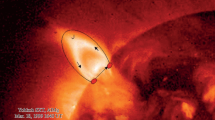Abstract
Oscillations of coronal loops with electric currents from one base to another are studied. The energy of longitudinal currents can be a source of energy for loop flares (Alfvén and Carlqvist, 1967). A simplified model of a loop in the form of a composite cylindrical magnetic tube containing a shell with a potential azimuthal magnetic field is considered for the theoretical study of oscillations of loops with longitudinal currents. The dispersion features of the tube natural kink oscillations are considered based on numerical calculations.
Similar content being viewed by others
Avoid common mistakes on your manuscript.
1 INTRODUCTION
The known idea of a loop flare is based on the assumption of the existence of electric currents flowing in coronal loops from one base to another (Alfvén and Carlqvist, 1967). The concept of coronal electric currents is generally accepted and used in the study of various dynamic processes in the corona (Török et al., 2014; Stepanov and Zaitsev, 2018). It is used to describe energy release processes and particle acceleration (Zaitsev and Stepanov, 2017). The magnetohydrodynamic (MHD) theory of coronal oscillations was developed in a rather detailed linear approximation (Zaitsev and Stepanov, 1975; Edwin and Roberts, 1983). The bending oscillations of coronal loops directly observed in the ultraviolet range are one of the main objects studied in coronal seismology (Aschwanden, 2005; Stepanov et al., 2012). New observations of coronal loops by the Solar Dynamics Observatory provide a wealth of detailed information on the oscillations (Abedini, 2018).
Oscillations of loops containing longitudinal electric currents are studied in this paper. The magnetic field of such loops is in the form of twisted magnetic flux ropes that influence the nature of oscillations (Bahari and Khalvandi, 2017). The transverse distribution of the current in loops is still controversial (Török et al., 2014). While the external magnetic field surrounding the loops is directed along their axis, the longitudinal currents, if there are any, are neutralized. These are the coronal loops to be considered here, although, according to some observation data, there are also loops with an electric current that flows in only one direction (Kontogiannis, 2017).
The adopted, simplified loop model looks like a straight magnetic tube containing two surface currents with longitudinal components flowing in opposite directions, such that their sum is zero, i.e., the currents are neutralized. We previously studied the radial oscillations of this magnetic tube (Mikhalyaev and Khongorova, 2012; Khongorova et al., 2012). Its kink oscillations are studied in this work. Note that the theory of kink oscillations in the solar atmosphere, which includes the study of damping mechanisms related, in particular, to the MHD wave emission into the environment (Tsap and Kopylova, 2001), encounters difficulties, even in the thin magnetic-tube approximation (Tsap et al., 2018). Therefore, in this paper, we limit ourselves to the case in which the eigenfrequencies of the waves are real values, i.e., we consider free, sustained oscillations.
2 CORONAL LOOP MODEL
We consider a magnetic tube consisting of two coaxial, nested parts (Fig. 1). The central part, called a filament, is a homogeneous magnetic tube of radius \(b\); it contains a homogeneous longitudinal field and plasma density distribution, and is characterized by a constant Alfvén velocity \({{V}_{{\text{i}}}}\). The field structure in the external environment is similar, and the Alfvén velocity is \({{V}_{{\text{e}}}}\). Below, the \({\text{i}}\) and \({\text{e}}\) indices denote values related to the filament and external environment, respectively. In the outer part of the tube with radius \(a\), which we call the shell, the selected azimuthal field and potential are \(\left( {0,~~{{{{B}_{0}}} \mathord{\left/ {\vphantom {{{{B}_{0}}} {~\alpha r}}} \right. \kern-0em} {~\alpha r}},~0} \right)\) (Mikhalyaev, 2005). Here, \(\alpha \) is the parameter defining the spatial scale, and \(r\) is the radial coordinate in the cylindrical coordinate system, the \(Z\) axis of which coincides with the tube axis. We choose the plasma density in the shell, which decreases with the radius as \({{{{\rho }_{0}}} \mathord{\left/ {\vphantom {{{{\rho }_{0}}} {{{\alpha }^{2}}{{r}^{2}}}}} \right. \kern-0em} {{{\alpha }^{2}}{{r}^{2}}}}\). Here, the Alfvén velocity also takes a constant value denoted by \({{V}_{0}}\) (which is also used in Eq. (2)).
In coronal conditions, we disregard the gas pressure in comparison with the magnetic pressure. The following ratios can be derived from the requirements of pressure balance at the cylindrical surface boundaries: \({{B}_{{\text{i}}}}\alpha b = {{B}_{0}} = {{B}_{{\text{e}}}}\alpha a\). Discontinuities at the boundaries of the regions lead to the concentration of surface electric currents at the boundaries of these regions (Fig. 2): \({{j}_{\varphi }}\left( b \right) = {{j}_{z}}\left( b \right) = {{c{{B}_{{\text{i}}}}} \mathord{\left/ {\vphantom {{c{{B}_{{\text{i}}}}} {{\text{4}}\pi }}} \right. \kern-0em} {{\text{4}}\pi }}\); \({{j}_{\varphi }}\left( a \right) = {{j}_{z}}\left( a \right) = {{ - c{{B}_{{\text{e}}}}} \mathord{\left/ {\vphantom {{ - c{{B}_{{\text{e}}}}} {{\text{4}}\pi }}} \right. \kern-0em} {{\text{4}}\pi }}\). The longitudinal components of the current have opposite directions, and the total current in the tube is zero. The considered model is used, because it provides explicit analytical solutions of the MHD equations, although magnetic tubes with diffuse current distribution would be more realistic models.
3 BENDING OSCILLATIONS OF THE CORONAL LOOP
We consider fast magnetoacoustic modes in the form of kink disturbances that correspond to an azimuthal number of \(m = 1\). We are interested in the question of the existence of sustained free oscillations, which was studied earlier in detail for the case of a homogeneous magnetic tube (Zaitsev and Stepananov, 1975; Edwin and Roberts, 1983). The disturbances of the radial velocity can be written in the following form
The boundary conditions on the disturbed surfaces of the “filament–shell” and “shell–environment” interfaces for the velocity radial component and total pressure disturbance can be written as
The index “0” indicates the values related to the shell. In the filament and external environment, where the field is longitudinal and homogeneous, the dependence on the radial variable is expressed with Bessel functions. The corresponding expressions for the total pressure disturbance and the radial-velocity component are known from the theory of linear oscillations of a homogeneous magnetic tube:
Here, the derivatives of the corresponding functions are marked with primes, and values \({{A}_{1}}\) and \({{A}_{4}}\) are arbitrary constants. In the external environment, the distribution decreases rapidly with the radius; thus, the solution describes a fast magnetoacoustic wave that is localized in the tube or, in other words, trapped by the tube (trapped modes).
In the shell, the dependence on the radial variable is determined by the equation of the following form, which we call radial:
In addition to the zero singular point associated with the geometry of the problem, it has an additional end singular point \({{\xi }_{{\text{c}}}} = 1\), which has a resonance value. It corresponds to the value of the radial variable \({{r}_{{\text{c}}}} = {{{{V}_{0}}} \mathord{\left/ {\vphantom {{{{V}_{0}}} \omega }} \right. \kern-0em} \omega }\). The resonance can be given the following physical meaning: exactly one wavelength with a phase velocity of \({{V}_{0}}\) and frequency of \(\omega \) can be placed on the circumference of radius \({{r}_{{\text{c}}}}\).
We consider the solutions of the radial equation (6) in a unit circle:
thus excluding the resonance case that will be the subject of our special study. The determination of the equation for the zero singular point has solutions –1 and –3, which differ by an integer. Linearly independent solutions of the radial equation have singularities in the form of poles, and the latter solution contains an attached vector in the form of logarithm. The solutions have the following expansions:
The expansion coefficients are found from recurrent relations. The wave distribution in the cylindrical shell can be written in the form of their linear combination
with the arbitrary coefficients \({{A}_{2}}\) and \({{A}_{3}}\).
Substituting the found wave distributions into the boundary conditions, we obtain a homogeneous algebraic system for the arbitrary coefficients \({{A}_{1}},~{{A}_{2}},~{{A}_{3}},~\,\,{\text{and}}\,\,~{{A}_{4}}.\) The condition of system resolvability is met when its determinant is equal to zero. This leads to the dispersion equation, which binds the frequency \(\omega \) and the longitudinal wave number \(k\). The obtainment of the dispersion equation is a standard procedure for this kind of problem, so we omit its full presentation. The dispersion equation for kink oscillations can be written as the following equality
where
4 SPECTRUM OF KINK OSCILLATIONS
The dispersion equation is solved with respect to \(\omega \) for different values of \(k\) under the condition of the absence of resonance (7), which imposes the upper limit on the values of the wave number. On this basis, we limit ourselves to the consideration of long-wave oscillations (\(ka \ll 1\)). The equation is solved numerically with the finite sums in the expansions (8); the error related to the removal of the series remainder is controlled in the calculations. Figure 3 presents the results of the solution of the dispersion equation. For the typical coronal conditions, we choose \({{V}_{{\text{e}}}} > {{V}_{{\text{i}}}}\) and consider a number of values of the Alfvén velocity \({{V}_{0}}\), the principal characteristic of the shell. The main conclusion is that the sustained free oscillations exist.
Dispersion curves are constructed for the case of a relatively thick shell (\(a = {{4b} \mathord{\left/ {\vphantom {{4b} 3}} \right. \kern-0em} 3}\)) and a relatively thin shell (\(a = {{3.2b} \mathord{\left/ {\vphantom {{3.2b} 3}} \right. \kern-0em} 3}\)). The results show that thin shell parameters have an insignificant influence on its oscillation spectrum. The phase velocity slowly decreases with an increase in the value of the wave number, which is typical of kink oscillations of a homogeneous tube in the fundamental mode. The numerical values of the oscillation periods for the typical coronal parameters are close to the periods of a homogeneous magnetic tube, which are used as a model in coronal seismology. This indicates that the observed coronal loops may contain longitudinal electric currents.
The role of resonance in the behavior of kink oscillations must be studied for a more detailed analysis of oscillations over a wider range of the wave number values, and it is the subject of our further research.
5 CONCLUSIONS
The presence of electric currents in coronal loops is a universally recognized concept; therefore, the study of loop oscillations with these physical properties can be considered a relevant problem. The linear-oscillation model considered in the paper provides an algorithm to determine the spectrum of kink oscillations of a magnetic tube with an azimuthal component of the field. In the long-wave range, the oscillation-spectrum properties are similar to those of the homogeneous magnetic-tube oscillations.
The presence of resonance is a characteristic feature of the kink oscillations of the magnetic tube with an azimuthal component of the field. This is stipulated not by the usual radial variation of the Alfvén velocity, but by the existence of a surface, on which the time of wave propagation along a circumference of certain radius coincides with the Alfvén time. Here the value of the Alfvén velocity itself can be constant, independent of the radius. The study of the resonance is the subject of our special study.
REFERENCES
Abedini, A., Observations of excitation and damping of transversal oscillations in coronal loops by AIA/SDO, Sol. Phys., 2018, vol. 293, id 22.
Alfvén, H. and Carlqvist, P., Currents in the theory solar atmosphere and a theory of solar flares, Sol. Phys., 1967, vol. 1, pp. 220–228.
Aschwanden, M.J., Physics of Solar Corona. An Introduction with Problems and Solutions, Berlin–Heidelberg– New York: Springer, 2005.
Bahari, K. and Khalvandi, M.R., The effect of a twisted magnetic field on the nature of kink MHD waves, Sol. Phys., 2017, vol. 292, id 192.
Edwin, P.M. and Roberts, B., Wave propagation in a magnetic cylinder, Sol. Phys., 1983, vol. 88, pp. 179–191.
Khongorova, O.V., Mikhalyaev, B.B., and Ruderman, M.S., Fast sausage waves in current-carrying coronal loops, Sol. Phys., 2012, vol. 280, pp. 153–163.
Kontogiannis, I., Georgoulis, M.K., and Park, S., Non-neutralized electric currents in solar active regions and flare productivity, Sol. Phys., 2017, vol. 292, id 159.
Mikhalyaev, B.B., Fast damping of the oscillations of coronal loops with an azimuthal magnetic field, Astron. Lett., 2005, vol. 31, no. 6, pp. 406–413.
Mikhalyaev, B.B. and Khongorova, O.V., Radial oscillations of current-carrying coronal loops, Astron. Lett., 2012, vol. 38, no. 10, pp. 667–671.
Stepanov, A.V. and Zaitsev, V.V., Magnitosfery aktivnykh oblastei Solntsa i zvezd (The Magnetospheres of Active Regions of the Sun and Stars), Moscow: Fizmatlit, 2018.
Stepanov, A.V., Zaitsev, V.V., and Nakariakov, V.N., Coronal Seismology. Waves and Oscillations in Stellar Coronae, Wiley, 2012.
Török, T., Leake, J.E., Titov, V.S., et al., Distribution of electric currents in solar active regions, Astrophys. J. Lett., 2014, vol. 782, id L10.
Tsap, Yu.T. and Kopylova, Yu.G., Acoustic damping of fast kink oscillations of coronal loops, Astron. Lett., 2001, vol. 27, pp. 737–744.
Tsap, Yu.T., Stepanov, A.V., and Kopylova, Yu.G., On the description of transverse wave propagation along thin magnetic flux tube, Geomagn. Aeron. (Engl. Transl.), 2018, vol. 58, no. 7, pp. 942–946.
Zaitsev, V.V. and Stepanov, A.V., On the nature of type IV pulsations of solar radio emission. Plasma cylinder oscillations (I), Issled. Geomagn., Aeron. Fiz. Solntsa, 1975, vol. 37, pp. 3–10.
Zaitsev, V.V. and Stepanov, A.V., Acceleration and storage of energetic electrons in magnetic loops in the course of electric current oscillations, Sol. Phys., 2017, vol. 292, id 141.
Funding
The paper was supported by the Russian Science Foundation, project no. 15-12-20 001.
Author information
Authors and Affiliations
Corresponding author
Ethics declarations
The authors declare no conflict of interest.
Additional information
Translated by N. Semenova
Rights and permissions
About this article
Cite this article
Mikhalyaev, B.B., Shividov, N.K., Derteev, S.B. et al. Kink Oscillations of Coronal Loops with a Longitudinal Electric Current. Geomagn. Aeron. 60, 1132–1136 (2020). https://doi.org/10.1134/S0016793220080162
Received:
Revised:
Accepted:
Published:
Issue Date:
DOI: https://doi.org/10.1134/S0016793220080162







